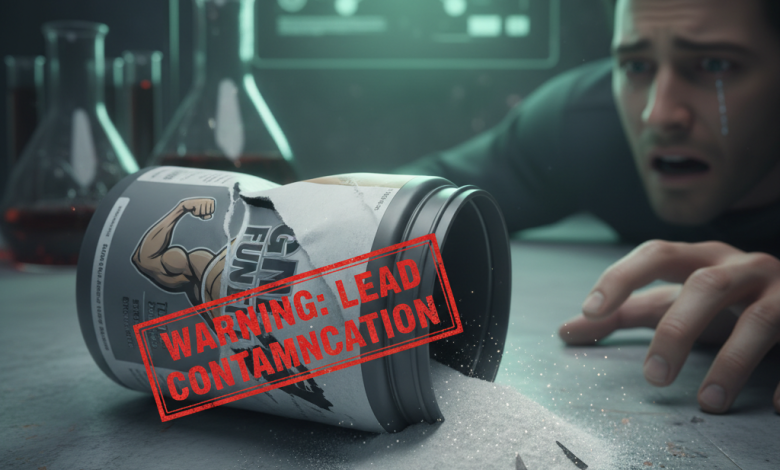Popular Protein Powders Found Contaminated with Dangerous Levels of Lead!

If you’ve ever scooped up a tub of protein powder believing it was a healthy shortcut to better fitness, you’re far from alone. Millions of people purchase these products seeking muscle gains, recovery boosts, or simply a convenient way to hit daily protein goals. But what if the very product you rely on is silently exposing you to a toxic heavy metal? Recent investigations show that many of the most popular protein powders may contain dangerously high levels of lead.
The Alarming Discovery
A recent report by Consumer Reports revealed some shocking statistics: of 23 protein powders and ready-to-drink shakes tested, over two-thirds contained more lead in a single serving than what the researchers deemed acceptable for daily consumption.
Plant-based powders were the worst offenders. For example, one product—Naked Nutrition Vegan Mass Gainer—was found to contain 7.7 micrograms of lead per serving, which is more than 15 times the level that Consumer Reports set as their “level of concern” (0.5 micrograms per day). Another, Huel Black Edition, clocked in at 6.3 micrograms per serving.
These findings come from an investigation spanning three months, multiple samples of each product, and purchases through online retailers like Amazon and brick-and-mortar stores.
But it’s not just Consumer Reports. The Clean Label Project (CLP) conducted an even broader analysis: 160 products from 70 brands, representing more than 80% of the marketplace, were tested for heavy metals, including lead. They found nearly half of the products exceeded safety thresholds for heavy metals.
In short, the protein powder aisle may no longer be as innocuous as you believed.
Why Is This Happening?
Plant-Based Sources Absorb More Toxins
One major reason for elevated lead levels: if it’s plant-based, it might absorb more heavy metals. According to the CLP, plant-based powders had three times the lead of whey-based alternatives.
Why? Plants draw nutrients from the soil—but if that soil is contaminated with industrial by-products, heavy metal run-off, or even naturally occurring lead, the plants absorb it too. That means peas, rice, soy, hemp—all of which feed into vegan protein powders—can carry heavier burdens of lead.
“Organic” Doesn’t Always Mean Safer
Paradoxically, many organic-labeled protein powders fared worse in contamination tests. The CLP found that organic powders had three times more lead and twice as much cadmium as non-organic powders.
The reasoning? Organic certification does not necessarily include heavy-metal screening or guarantee clean soils. So a product can be organic (no synthetic pesticides, etc) yet still be grown in soil with high heavy-metal content.
Flavoring and Manufacturing Matter
Chocolate-flavoured powders were flagged as especially risky. These powders sometimes contained 4× more lead, and up to 110× more cadmium than their vanilla counterparts.
This is likely because cacao plants (used in chocolate flavouring) are known to draw heavy metals from soil. When those plants are processed into flavours or powders, the heavy-metal residues make their way into the finished product.
Regulatory Gaps
Unlike foods, dietary supplements and powders often operate in a regulatory grey zone. The U.S. Food & Drug Administration (FDA) does not always pre-approve protein powders for heavy-metal safety before sale.
That means manufacturers have a lot of responsibility—and many do test—but there is no universal enforcement of limits or consistent transparency across brands.
The Health Risks of Lead
You might think: “But I use protein powder occasionally. How bad could it be?” The answer: it depends on how much, how often, and who you are.
Why Lead Is Dangerous
Lead is a well-documented toxin. While acute poisoning gets attention, the real danger comes from chronic low-level exposure. Over time, even small amounts can accumulate and cause harm.
Potential health consequences include:
- Cognitive and neurological damage — especially concerning for children and developing fetuses.
- High blood pressure, kidney dysfunction, and cardiovascular risks in adults.
- Reproductive issues, immune suppression, and general systemic stress.
Importantly, there is no safe level of lead exposure. The FDA and many experts emphasize that even trace amounts carry risk.
Protein Powders + Habitual Use = Higher Risk
If you’re a daily user of protein powders, especially those marketed for “mass-gainer” or high-serving use, your risk of cumulative exposure goes up. One serving of a problematic product may present a heavy-metal burden that adds up across weeks or months.
For example, if one serving contains 6 micrograms of lead, and you take it every day, that’s 42 micrograms a week. Multiply by months or years—and the hidden exposure becomes a real concern.
For Vulnerable Groups, the Risk Is Even Greater
Pregnant individuals, breastfeeding parents, children, and adolescents are especially vulnerable. Their developing brains and systems are far less capable of clearing toxins, and damage can be lifelong. If you fall into one of these groups, you need to take heed.
What You Can Do Right Now
Don’t panic. You don’t necessarily need to throw out every tub of powder in your cupboard. But you do need to act and become an informed consumer.
1. Reduce Frequency
If you use protein powder every day, consider scaling back—especially if it’s plant-based, chocolate-flavoured, or you can’t verify third-party safety testing. Using it less often (e.g., a few times a week) will reduce accumulation risk.
2. Prefer Whey or Beef-Based Proteins
Studies consistently found that powders derived from milk (whey) or beef have lower lead levels compared to many plant-based powders. If you tolerate dairy or beef-derived proteins, this may be a safer route.
3. Check for Third-Party Certification
Look for brands that display clear testing for heavy metals—certifications like NSF International, USP (United States Pharmacopeia), or independent lab results. These aren’t guarantees, but they’re positive signs of transparency.
4. Read Ingredient Sources & Flavouring
Be cautious of products with “organic plant-based protein” buzzwords—but lack transparent sourcing. Be extra cautious with chocolate-flavoured powders. If ingredient sourcing is vague (e.g., “proprietary blend”), that’s a red flag.
5. Diversify Your Protein Sources
You don’t need to rely solely on powders. Whole foods—lean meats, eggs, dairy, legumes, and plant-based alternatives—provide protein without the same risk of concentrated heavy-metal exposure. This is especially relevant since many people already get enough protein without supplements.
6. Stay Updated & Ask Brands Questions
If you stick with the same brand, reach out to ask for their most recent heavy-metal testing. If they can’t provide it, consider switching. Also, monitor updates from consumer-safety groups or news outlets about products being flagged.
Your Story Could Help Others
Here’s where you come in. You’re not just a passive consumer—you’re part of the community. By sharing your journey, you can help friends, gym-buddies, and followers avoid the hidden risk that many don’t even know about.
Imagine telling your audience or colleagues: “I thought my daily protein shake was helping me—until I found out about the heavy-metal issue. Here’s how I changed my routine, and you can too.” That kind of honesty builds trust, sparks dialogue, and encourages safer habits.
If you’re a coach, influencer, gym-owner, or just someone who cares about health, this is a conversation worth having. Highlighting science, sharing practical steps, and being transparent about your own adjustments gives your voice credibility—and it differentiates you in a crowded wellness space.
Wrap-Up: Take Control of Your Health
The headlines are clear: many protein powders—especially plant-based, organic, or chocolate-flavoured ones—carry higher than ideal levels of lead. The evidence is mounting, the risks are real, and the regulatory framework is still catching up.
What matters now is action. Use fewer servings, choose safer options, diversify your protein intake, look for transparency, and share what you learn. By doing so, you protect yourself and help protect others.
Because your health is not just about gains, it’s about safe gains.




